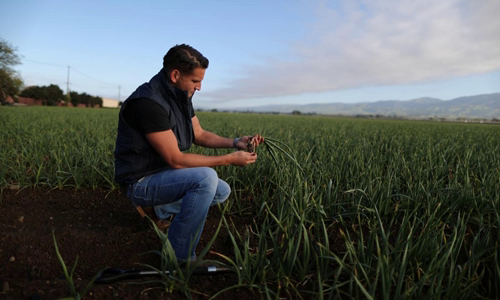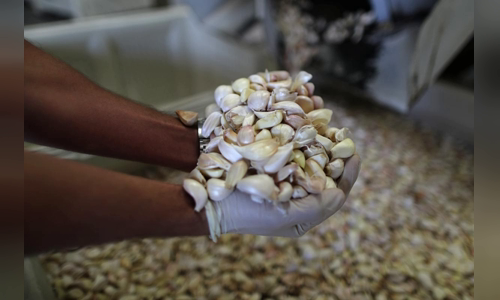Garlic farmers in the United States rejoice when they finally reach victory after 25 years of competing with Chinese goods, thanks to Trump.
"It is wrong to say that no one has won the trade war," said Ken Christopher, vice president of garlic production firm Christopher Ranch in Gilroy City, California, USA. "Only when President Donald Trump's tariffs on Chinese garlic take effect will this product really become competitive in California."

Ken Christopher at his family's garlic field in Gilroy, California, USA, March 29 Photo: Reuters
Since the early 1990s, garlic farmers in the US have begun to complain that Chinese garlic is rampant in the country market at prices well below production costs, allegedly as "dumping". . The government then investigated and concluded in 1994 that some Chinese companies were actually selling garlic "below the reasonable price" in the US.
As a result, any violating Chinese company is taxed up to 277%. However, they soon found many measures to "bypass the law" on a case-by-case basis, as simple as establishing a new frontier enterprise.
Christopher likens this situation to a "rat-hitting game", which means that there are always new "niches" to avoid punishment and cannot solve the problem thoroughly. Therefore, Chinese garlic still floods the US market. Of the 12 US commercial garlic farms operating in the 1990s, only the three largest producers survived.
However, farmers still cling to say that Trump's tariffs on Chinese garlic are now effective, because it is applied comprehensively and immediately. Importing companies have no means to evade them. The U.S. initially imposed a 10% tax on Chinese garlic in September 2018, then increased to 25% in May.
Christopher Ranch was one of only three American garlic companies to withstand hardship in the 1990s. Today, their output reaches 45 million kilograms per year, providing nearly a third of the freshly consumed garlic. in the USA. Christopher said the family company's sales have skyrocketed since the first round of import duty on Chinese garlic came into effect.
According to data from the US Department of Agriculture in August 2018, a 13.6-kilogram box of Chinese white garlic cost US $ 25-30 in Boston, while the equivalent amount of California garlic costs US $ 68. After the tariffs were applied, the price of Chinese garlic rose to $ 52-55 and California garlic was $ 70-74. Although Chinese garlic is still cheaper, the price gap has narrowed significantly.

Garlic is harvested on the farm of Christopher Ranch Photo: Reuters
However, Jack Vessey, a fourth-generation California farmer, could not benefit from the "alternating wind". His family's Vessey & Company stopped growing garlic a few years ago because it was unable to make a profit against the competition of imported Chinese goods.
"Leaving the garlic business was a very difficult decision for me. The three previous generations spent most of their lives growing this food. However, giving businesses the opportunity to survive until the fifth generation, we were forced to divest our investment in garlic, "Vessey said.
His family has been growing garlic along with some vegetables like cabbage and cauliflower for almost 100 years. "Garlic has accounted for more than 50% of our revenue over the years, but after China started dumping its products in the US market, we had to cut back on the acreage and move on to other businesses." , Vessey said.
Frank Lavin, a former US Department of Commerce official, said the problem was that Chinese importers were too quick to respond to Washington's tax measures in 1994. "To avoid being detected and sentenced. penalties, they just need to set up another fake entity. The fact that they are faster than US customs, "he said.
Christopher praised Trump's tax moves not like that. "They are very easy to execute, because garlic cannot even enter the United States without being taxed. This has changed the game strategically," he said, adding that the American media made a mistake. when attacking the President's tariff policy.
"The press is constantly reporting that taxes are hurting American farmers, while it really benefits the domestic garlic business," the 33-year-old said.



 MdAuladHossain
MdAuladHossain







